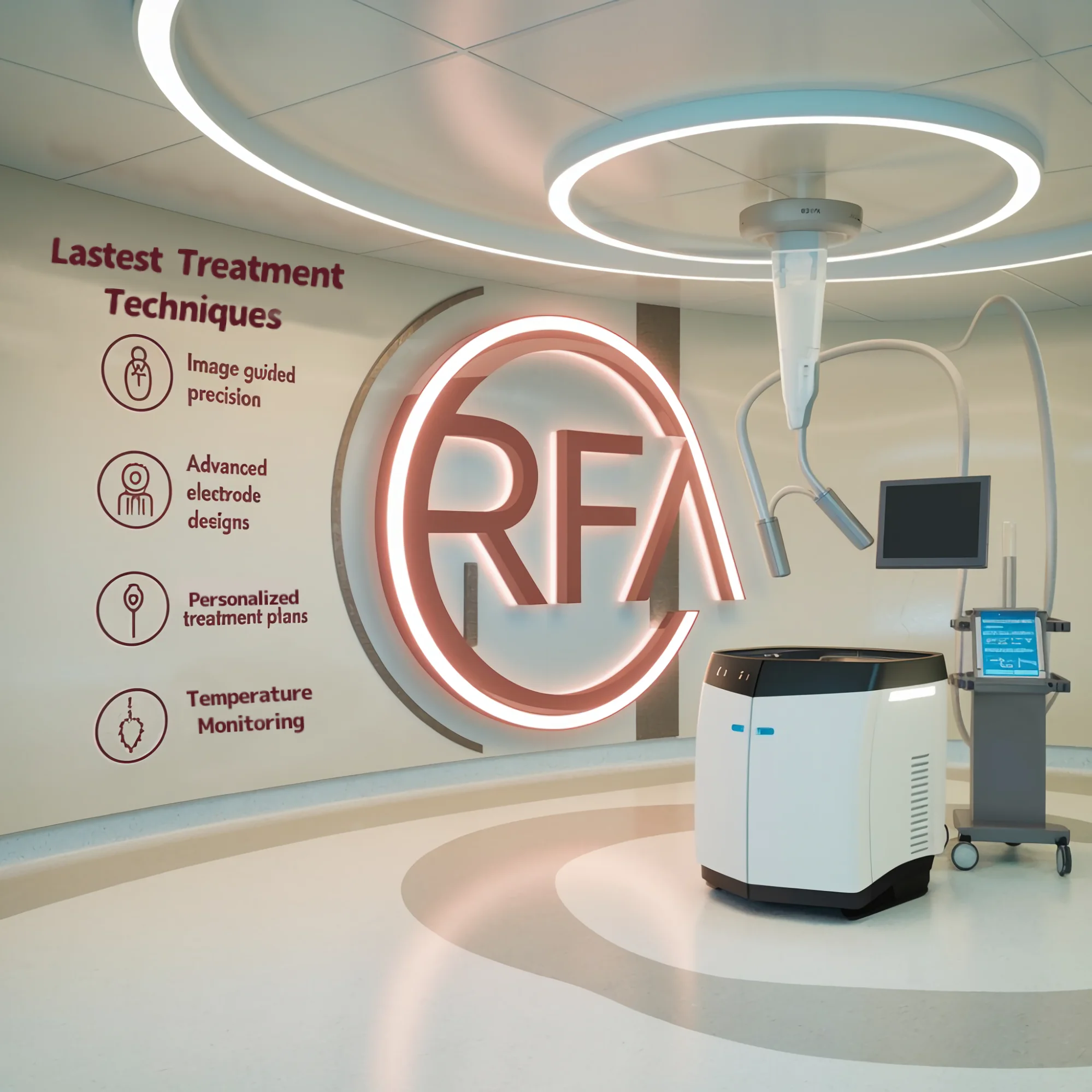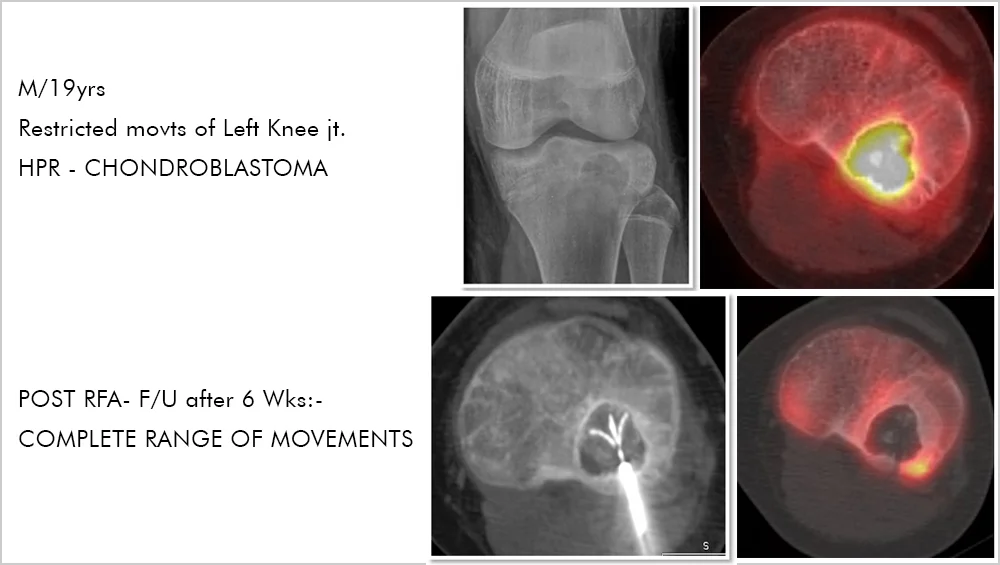Percutaneous Radio-frequency Ablation (RFA) of Tumours
- Home
- Percutaneous Radio-frequency Ablation (RFA) of Tumours
Percutaneous Radio-frequency Ablation (RFA) is a cutting-edge, minimally invasive procedure used to treat various types of tumors, particularly in the liver, kidneys, lungs, and bones. Using thermal energy generated by radio waves, RFA destroys cancerous tissues while preserving surrounding healthy structures. It is a highly effective treatment for patients who are not candidates for surgery due to age, health conditions, or the location of the tumor.
In this article, we’ll delve into the causes and symptoms that lead to RFA, discuss the benefits of early treatment, explore the latest techniques, and answer frequently asked questions to help you make informed decisions.
Causes
RFA is commonly used to treat tumors caused by conditions such as:
- Primary Liver Cancer (Hepatocellular Carcinoma): Often linked to chronic liver diseases like hepatitis or cirrhosis.
- Metastatic Tumors: Cancers that have spread from other organs, such as the colon or breast, to the liver or lungs.
- Renal Tumors: Small kidney tumors, particularly in patients with compromised kidney function.
- Bone Tumors: Often used for pain relief in patients with metastatic bone cancer.
- Lung Tumors: For patients who are not surgical candidates, RFA can effectively target small, localized tumors.
These underlying conditions can lead to tumor growth, necessitating effective and minimally invasive interventions like RFA.

Symptoms
Patients who may benefit from RFA often present with:
- Localized Pain: Particularly in cases of bone or soft tissue tumors.
- Abnormal Blood Tests: Indicating impaired organ function, such as elevated liver enzymes.
- Weight Loss and Fatigue: Common symptoms in cancer patients.
- Imaging Abnormalities: Tumors detected during CT, MRI, or ultrasound scans.
- Respiratory Issues: For lung tumors, symptoms may include shortness of breath or chronic cough.
Prompt diagnosis and treatment are crucial to managing symptoms and preventing the progression of cancer.
Benefits of Early Treatment
Undergoing RFA at an early stage offers numerous advantages:
- Minimally Invasive: Performed through a small incision, resulting in minimal pain and faster recovery.
- Targeted Treatment: Precisely destroys tumor cells while sparing healthy tissue.
- Quick Recovery: Most patients resume normal activities within a few days.
- Outpatient Procedure: RFA is often performed as a same-day procedure, reducing hospital stays.
- Improved Quality of Life: Relieves symptoms like pain and fatigue, enhancing patient comfort.
- Alternative to Surgery: Ideal for patients who cannot undergo surgical tumor removal.
Preparation for the Procedure
To ensure the success of RFA, patients should follow these preparation steps:
- Fasting: Avoid eating or drinking for six hours before the procedure.
- Medication Review: Inform your doctor about any blood-thinning medications, which may need to be temporarily stopped.
- Pre-Procedure Imaging: Expect to undergo imaging scans to confirm the tumor’s location and plan the procedure.
- Comfortable Clothing: Wear loose clothing on the day of the procedure for ease of movement and comfort.
Aftercare Instructions
Post-procedure care is critical for recovery and to minimize complications:
- Rest: Avoid strenuous activities for 48 hours after the procedure.
- Wound Care: Keep the incision site clean and dry to prevent infection.
- Monitor Symptoms: Watch for signs of complications such as fever, excessive pain, or bleeding, and report them to your doctor immediately.
- Follow-Up Visits: Schedule follow-up appointments for imaging to assess the effectiveness of the treatment.

Latest Treatment Techniques
Advancements in technology have significantly improved the safety and efficacy of RFA. Key innovations include:
- Image-Guided Precision: Real-time imaging using CT, MRI, or ultrasound ensures accurate placement of the RFA probe.
- Advanced Electrode Designs: Modern probes are equipped with expandable electrodes that deliver energy uniformly, enhancing tumor destruction.
- Combination Therapies: RFA is often combined with other treatments like transarterial chemoembolization (TACE) for better outcomes.
- Personalized Treatment Plans: Tailored approaches based on tumor size, location, and patient health.
- Temperature Monitoring: Advanced systems measure and control tissue temperatures to optimize results and prevent damage to nearby structures.
These techniques have made RFA a preferred option for many patients, offering effective treatment with fewer complications.

Case Studies
Case 1: Successful Liver Tumor Ablation
A 60-year-old female patient with a history of operated colon cancer was referred for RFA to treat a solitary liver metastasis. The procedure was performed successfully, and post-treatment scans showed complete tumor ablation, allowing the patient to resume daily activities.

Case 2: Pain Relief from Bone Tumor
A 19-year-old male presented with severe leg pain and restricted movement. Imaging revealed a lytic lesion in the knee joint, confirmed as chondroblastoma through biopsy. RFA provided significant pain relief and improved mobility, enhancing the patient’s quality of life.

Conclusion
Percutaneous Radio-frequency Ablation (RFA) is a revolutionary procedure for managing various tumors. Its minimally invasive nature, combined with precise targeting and high success rates, makes it an essential tool in modern cancer care. Whether used as a standalone treatment or in combination with other therapies, RFA has transformed outcomes for patients with cancer.
If you or a loved one are exploring treatment options for tumors, consult with a specialist to determine if RFA is right for you. Early intervention can significantly improve outcomes and enhance your quality of life.
For expert advice or to schedule a consultation, contact us here.
Frequently Asked Questions (FAQs)
RFA is a minimally invasive procedure that uses thermal energy to destroy cancerous tissues. A thin probe is inserted through the skin into the tumor, where radio waves generate heat to eliminate cancer cells.
Patients with small, localized tumors who are not suitable for surgery due to health conditions or tumor location are ideal candidates. It is commonly used for liver, kidney, lung, and bone tumors.
The RFA procedure typically takes 1-2 hours, depending on the size and location of the tumor. Most patients can go home the same day.
While RFA is generally safe, potential risks include infection, bleeding, or damage to nearby organs. These risks are minimized with advanced imaging and experienced specialists.
Recovery is usually quick, with most patients resuming normal activities within a few days. Mild discomfort at the insertion site is common but temporary.
Yes, RFA is often combined with therapies like chemotherapy, immunotherapy, or TACE to enhance effectiveness.
RFA is minimally invasive, offering faster recovery and fewer risks compared to surgery. Unlike systemic treatments like chemotherapy, it targets tumors locally, reducing side effects.
Patients should schedule regular imaging studies to monitor the treated area and ensure the tumor has been fully ablated.
For more insights, explore our pages on Liver Cancer TACE or Biopsy Test for diagnostic support.
Would you like to request an appointment?
You can call on +91-98200 86520 for Appointments or fill the form below
If you’re experiencing symptoms, contact us today to schedule a consultation. Our experienced specialists will help you choose the best treatment for your condition.
